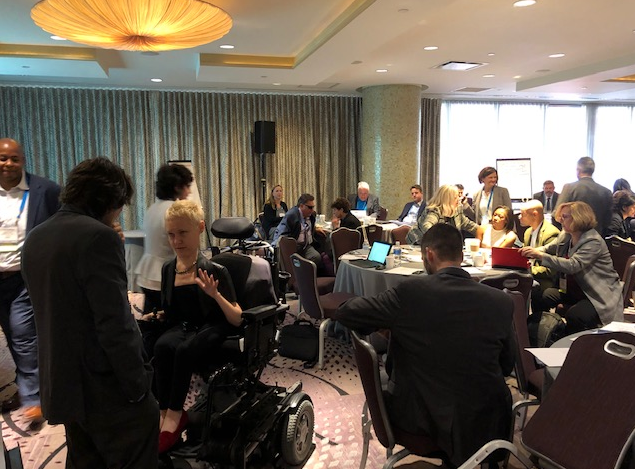Can Mapping Sidewalks Increase Ridership?
- Author: William Reckley
- Date: December 31, 2019
What is sidewalk mapping, and how can mobility management practitioners use it to understand the accessibly of our built environment?…
By Kristen Joyner, Ron Brooks, and Jerom Theunissen
The emergence of new mobility services and innovative technology have the potential to ensure access to multiple transportation options for all. In the last ten years, a plethora of shared-use mobility service providers has emerged that leverages advancements in mobile technology and digital platforms to connect riders with transportation across diverse modes. However, some of these partnerships raise concerns regarding equitable access to services for people with disabilities, seniors and/or low-income riders. The accessibility of these new services is an essential consideration to providing enhanced mobility for all. With an increasing number of public & private providers entering this space, serious considerations are needed to ensure that everyone, including people with disabilities, have access to equitable shared-use mobility service with high-quality standards.
In response to this growing need, the former U.S. Department of Transportation Secretary Anthony Foxx published a “Dear colleague” FTA guidance in December 2016, advising transit agencies that they are obliged to “ensure equity and access as you partner with TNCs.” The guidance clarified that ADA regulations apply regardless of federal funding and apply to public and private transportation providers. What’s more, demand-responsive service needs to be deemed “equivalent” to services provided to other individuals in the areas of:

As detailed in TCRP Report 204, these requirements for equivalent service have been a major barrier for successful partnerships between transit agencies and TNCs. Challenges include a lack of a fleet of wheelchair accessible vehicles for many shared-use mobility providers, adequate response time for these vehicles, and adoption by customers who use wheelchairs. Other issues include the lack of trained drivers with disability sensitivity training and system accessibility for booking trips that address the needs of the full spectrum of disabilities.
At the APTA TRANSform meeting in New York City, the importance of this topic was deliberated by public transportation stakeholders at the workshop, “The Challenges and Opportunities of Accessibility within the New Mobility Paradigm.” In case you missed it – here is a brief overview and a few key takeaways:
The workshop started with the question: Are the terms Accessibility and Mobility the same or different and why? For some, they are the same. When a community is accessible for people with disabilities and seniors, then mobility options grow. For others, the two terms are vastly different. Accessibility directly refers to the individual with a disability, who faces a barrier to use services, independently. Mobility means the changing landscape of options to access places in a community, or coverage span, seamlessly. There was no clear decision, only more questions and ideas to consider.
Workshop speakers and participants also shared several examples of efforts being made to enhance accessibility within the new mobility paradigm. Topics covered included the use of Google Transit Feed Specifications (GTFS) Flex in the GoVermont trip planner to allow for better integration of paratransit options within transportation ecosystems, efforts being made to implement accessible first/last mile and microtransit systems, and work being done to ensure that self-driving cars hit the streets with universal accessibility built-in. Participants also heard from the Federal Transit Administration and Department of Justice representatives on the federal government’s perspectives regarding the need for equity and accessibility within the new mobility paradigm.
The conference venue was just off Broadway, and in keeping with the entertainment theme, the workshop left everyone wanting more. With this in mind, the Access and Mobility Management committees of APTA will continue collaborating on workshops, developing online resources, and discussing these critical topics. Going forward, it will be the role of mobility management practitioners in the community to assess how new mobility services fit into meeting the transportation needs of typically disadvantaged groups. This will be necessary in the continuing quest to coordinate services, overcome barriers, and help guarantee mobility for all in the community.
Image credit: Jerom Theunissen
Have more mobility news that we should be reading and sharing? Let us know! Reach out to Sage Kashner (kashner@ctaa.org).
Please confirm you want to block this member.
You will no longer be able to:
Please note: This action will also remove this member from your connections and send a report to the site admin. Please allow a few minutes for this process to complete.